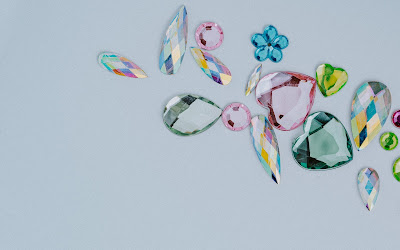Rhinestones have a dazzling history. Rhinestones were originally used to refer to Czechoslovakian or Bohemian glass, which dates back to the 13th century in Bohemia and the Czech Republic. Both have a rich history of hand-blown glass as well as molded and cut glass.
The glass was no longer limited to functional goods by 1918. Czechoslovakian glass first appeared as bright and magnificent jewelry. Rhinestones were created from Czech glass.
Rhinestones were artificial gems made of highly refined glass. The glass was tinted to the desired color by utilizing several metals. After that, it was pressed into molds. Each stone was machine ground and polished, resulting in a beautiful glass stone. The stones were frequently foiled on the back, which amplified their radiance.
The same refining procedure is still utilized today. Rhinestones are frequently referred to as paste. Originally, the paste was a glass stone formed of crushed glass that was shaped and then melted to create an opaque, dense glass frosted stone. There were numerous air bubbles and swirl marks in the paste. The high lead concentration glass was then polished and faceted before being put on copper or silver to create a beautiful stone. Rhinestones are commonly referred to as paste nowadays. Rhinestones are also known as paste, strass, and diamante in Europe.
Austria is another country with a long history of rhinestone manufacturing. Daniel Swarovski invented a revolutionary glass cutting the machine in 1891, which essentially changed the jewelry industry. This machine was capable of cutting faceted glass and creating a finely finished product in a relatively short period. Prior to this discovery, each stone would have to be hand cut and finished, which would take a very lengthy time. Swarovski's background in glassmaking, along with his glass cutting machine, led to the production of rhinestones with a lead content of more than 30%.
These rhinestones shone brighter than anything else on the market. Swarovski wasn't satisfied with his creation and the greatest rhinestones on the market. His next invention transformed the jewelry industry once more. He developed a vacuum plating technique for the backs of the stones, decreasing the requirement for hand labor. Swarovski rhinestones are still regarded as the top quality in the business. Swarovski rhinestones are used in more than 80% of rhinestone jewelry made in the United States.
For hundreds of years, rhinestones have played an essential part in costume jewelry. It is utilized to accentuate, and accents and rhinestones can occasionally furnish the complete design. During the Victorian era, popular jewelry motifs included snakes, flowers, and hands, which were frequently decorated with rhinestones.
The 1890s was a time for lavish jewelry studded with rhinestones. As time passed, designs got simpler, with figural shapes making a fashion statement once more. This time, though, they were smaller and more elegant, with little rhinestone embellishments.
Extravagance had made a comeback during the Edwardian period, with diamonds and pearls being the center point. Rhinestones were once again popular and frequently used to simulate the actual thing.
Fashions were fast evolving in the 1920s. Dresses had transitioned from fitting to a looser, more relaxed fit. During this period, two separate styles emerged: the feminine style and the androgynous style. The art deco era inspired jewelry from the 1920s. Clear rhinestones were used in the majority of rhinestone jewelry.
As the 1920s progressed, jewelry became more daring. Colors with a lot of contrast were popular. Coco Chanel was a pivotal influence in establishing the tone for this era's jewelry.
Labor-intensive fashion was no longer practicable during the 1930s downturn. While the globe was chaotic, many women found affordable comfort in jewelry. Costume jewelry is an inexpensive way to update an outdated outfit. The business began to make brightly colored enamel pieces with rhinestone accents. Rhinestone-eyed dogs, birds, and cats were common.
During the 1940s, jewelry became once again enormous and flamboyant, with rhinestones being made in every imaginable hue and massive stones placed on large bold settings being the norm.
By the 1950s, women had two distinct looks: elegant and sophisticated for older women and casual and fun for younger women. Jewelry made entirely of rhinestones was popular in the 1950s. For the younger woman, there were flirtatious pieces, while for the older woman, there was refined elegance. Rhinestone parures quickly became trendy.
The aurora borealis rhinestone, with its fantastic display of colors, was launched to the market in 1953. It was an instant success!
Women were wearing very utilitarian attire during the 1960s. Hippie styles, with their roots in Mother Nature, were immensely fashionable by the late 1960s. Tie-dyed shirts, long flowing skirts, and torn jeans were all over the place. Rhinestone jewelry was not popular among this generation.
By the mid-1970s, the punk aesthetic had emerged, and the rhinestone had been resurrected. The disco era was responsible for reintroducing rhinestones to the mainstream. During the 1980s, the disco style evolved into the club movement, and rhinestone jewelry remained fashionable.
Rhinestones have been popular in the jewelry industry since the 1970s. They are becoming increasingly popular, and there is a style to fit practically every purpose. There is rhinestone jewelry for a wedding, rhinestone jewelry for a prom girl, rhinestone jewelry for the young and fun crowd, corporate women, intelligent women, and mature women. Almost every woman's accessories are adorned with lovely rhinestone jewelry.
If patterns indicate the rhinestone's future, it appears to have a long and prosperous life ahead of it. Pleasing for most fashionable women who know the value and beauty of rhinestones!




0 Comments